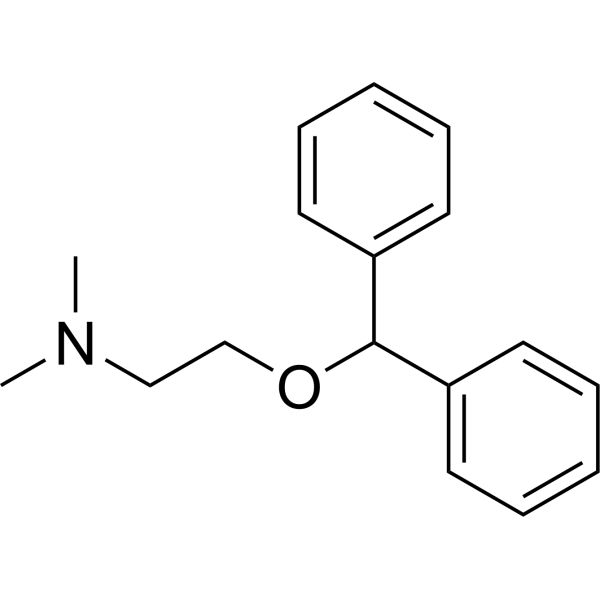
Diphenhydramine
CAS No. 58-73-1
Diphenhydramine ( Syntedril; PM255; PM-255; Diphenhydramine; Dabylen; Debendrin )
Catalog No. M27401 CAS No. 58-73-1
Diphenhydramine, a first-generation antihistamine possessing antiemetic, antitussive, anticholinergic, and sedative properties, is mainly used in the treatment of allergies.
Purity : >98% (HPLC)
 COA
COA
 Datasheet
Datasheet
 HNMR
HNMR
 HPLC
HPLC
 MSDS
MSDS
 Handing Instructions
Handing Instructions
| Size | Price / USD | Stock | Quantity |
| 5MG | 45 | In Stock |


|
| 10MG | 68 | In Stock |


|
| 25MG | 115 | In Stock |


|
| 50MG | 173 | In Stock |


|
| 100MG | 258 | In Stock |


|
| 200MG | 31 | In Stock |


|
| 500MG | 50 | In Stock |


|
| 1G | Get Quote | In Stock |


|
Biological Information
-
Product NameDiphenhydramine
-
NoteResearch use only, not for human use.
-
Brief DescriptionDiphenhydramine, a first-generation antihistamine possessing antiemetic, antitussive, anticholinergic, and sedative properties, is mainly used in the treatment of allergies.
-
DescriptionDiphenhydramine, a first-generation antihistamine possessing antiemetic, antitussive, anticholinergic, and sedative properties, is mainly used in the treatment of allergies. Diphenhydramine is also used in the management of drug-induced parkinsonism and other extrapyramidal symptoms.
-
SynonymsSyntedril; PM255; PM-255; Diphenhydramine; Dabylen; Debendrin
-
PathwayGPCR/G Protein
-
TargetHistamine Receptor
-
RecptorParasite
-
Research Area——
-
Indication——
Chemical Information
-
CAS Number58-73-1
-
Formula Weight255.4
-
Molecular FormulaC17H21NO
-
Purity>98% (HPLC)
-
Solubility——
-
SMILESCN(C)CCOC(C1=CC=CC=C1)C2=CC=CC=C2
-
Chemical Name——
Shipping & Storage Information
-
Storage(-20℃)
-
ShippingWith Ice Pack
-
Stability≥ 2 years
Reference
1.Ting Zhou, et al. A hPSC-based Platform to Discover Gene-Environment Interactions That Impact Human β-cell and Dopamine Neuron Survival. Nat Commun. 2018 Nov 16;9(1):4815.
molnova catalog


related products
-
cysteine
Cysteine is a naturally occurring, sulfur-containing amino acid which is important for protein synthesis, detoxification, and also exerts diverse metabolic functions.
-
Deguelin
Deguelin is a PI3K/AKT Inhibitor, which is a natural product isolated from plants in the Mundulea sericea family.
-
Ciproxifan maleate
Ciproxifan maleate(FUB-359 maleate) is a highly potent and selective histamin H3-receptor antagonist with IC50 of 9.2 nM, with low apparent affinity at other receptor subtypes.



 Cart
Cart
 sales@molnova.com
sales@molnova.com


